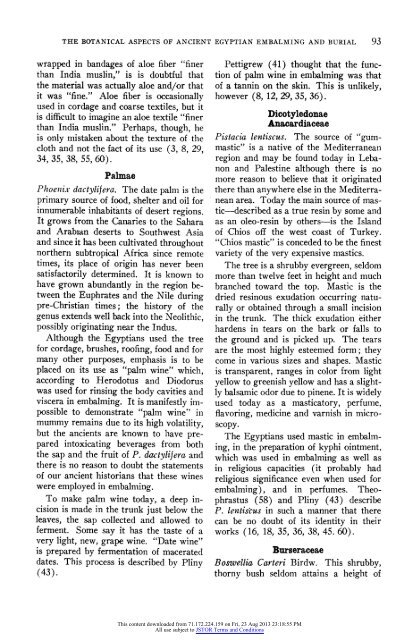The Botanical Aspects of Ancient Egyptian Embalming and Burial
The Botanical Aspects of Ancient Egyptian Embalming and Burial
The Botanical Aspects of Ancient Egyptian Embalming and Burial
You also want an ePaper? Increase the reach of your titles
YUMPU automatically turns print PDFs into web optimized ePapers that Google loves.
THE BOTANICAL ASPECTS OF ANCIE!NT EGYPTIAN EMBALMING AND BURIAL 93<br />
wrapped in b<strong>and</strong>ages <strong>of</strong> aloe fiber "finer<br />
than India muslin," is is doubtful that<br />
the material was actually aloe <strong>and</strong>/or that<br />
it was "fine." Aloe fiber is occasionally<br />
used in cordage <strong>and</strong> coarse textiles, but it<br />
is difficult to imagine an aloe textile "finer<br />
than India muslin." Perhaps, though, he<br />
is only mistaken about the texture <strong>of</strong> the<br />
cloth <strong>and</strong> not the fact <strong>of</strong> its use (3, 8, 29,<br />
34, 35, 38, 55, 60).<br />
Palmae<br />
Phoeniix dactylifera. <strong>The</strong> date palm is the<br />
primary source <strong>of</strong> food, shelter <strong>and</strong> oil for<br />
innumerable inhabitants <strong>of</strong> desert regions.<br />
It grows from the Canaries to the Sahara<br />
<strong>and</strong> Arabian deserts to Southwest Asia<br />
<strong>and</strong> since it has been cultivated throughout<br />
northern subtropical Africa since remote<br />
times, its place <strong>of</strong> origin has never been<br />
satisfactorily determined. It is known to<br />
have grown abundantly in the region between<br />
the Euphrates <strong>and</strong> the Nile during<br />
pre-Christian times; the history <strong>of</strong> the<br />
genus extends well back into the Neolithic,<br />
possibly originating near the Indus.<br />
Although the <strong>Egyptian</strong>s used the tree<br />
for cordage, brushes, ro<strong>of</strong>ing, food <strong>and</strong> for<br />
many other purposes, emphasis is to be<br />
placed on its use as "palm wine" which,<br />
according to Herodotus <strong>and</strong> Diodorus<br />
was used for rinsing the body cavities <strong>and</strong><br />
viscera in embalming. It is manifestly impossible<br />
to demonstrate "palm wine" in<br />
mummy remains due to its high volatility,<br />
but the ancients are known to have prepared<br />
intoxicating beverages from both<br />
the sap <strong>and</strong> the fruit <strong>of</strong> P. dactylifera <strong>and</strong><br />
there is no reason to doubt the statements<br />
<strong>of</strong> our ancient historians that these wines<br />
were employed in embalming.<br />
To make palm wine today, a deep incision<br />
is made in the trunk just below the<br />
leaves, the sap collected <strong>and</strong> allowed to<br />
ferment. Some say it has the taste <strong>of</strong> a<br />
very light, new, grape wine. "Date wine"<br />
is prepared by fermentation <strong>of</strong> macerated<br />
dates. This process is described by Pliny<br />
(43).<br />
Pettigrew (41) thought that the function<br />
<strong>of</strong> palm wine in embalming was that<br />
<strong>of</strong> a tannin on the skin. This is unlikely,<br />
however (8, 12, 29, 35, 36).<br />
Dicotyledonae<br />
Anacardiaceae<br />
Pistacia lentiscus. <strong>The</strong> source <strong>of</strong> "gummastic"<br />
is a native <strong>of</strong> the Mediterranean<br />
region <strong>and</strong> may be found today in Lebanon<br />
<strong>and</strong> Palestine although there is no<br />
more reason to believe that it originated<br />
there than anywhere else in the Mediterranean<br />
area. Today the main source <strong>of</strong> mastic-described<br />
as a true resin by some <strong>and</strong><br />
as an oleo-resin by others-is the Isl<strong>and</strong><br />
<strong>of</strong> Chios <strong>of</strong>f the west coast <strong>of</strong> Turkey.<br />
"Chios mastic" is conceded to be the finest<br />
variety <strong>of</strong> the very expensive mastics.<br />
<strong>The</strong> tree is a shrubby evergreen, seldom<br />
more than twelve feet in height <strong>and</strong> much<br />
branched toward the top. Mastic is the<br />
dried resinous exudation occurring naturally<br />
or obtained through a small incision<br />
in the trunk. <strong>The</strong> thick exudation either<br />
hardens in tears on the bark or falls to<br />
the ground <strong>and</strong> is picked up. <strong>The</strong> tears<br />
are the most highly esteemed form; they<br />
come in various sizes <strong>and</strong> shapes. Mastic<br />
is transparent, ranges in color from light<br />
yellow to greenish yellow <strong>and</strong> has a slightly<br />
balsamic odor due to pinene. It is widely<br />
used today as a masticatory, perfume,<br />
flavoring, medicine <strong>and</strong> varnish in microscopy.<br />
<strong>The</strong> <strong>Egyptian</strong>s used mastic in embalming,<br />
in the preparation <strong>of</strong> kyphi ointment,<br />
which was used in embalming as well as<br />
in religious capacities (it probably had<br />
religious significance even when used for<br />
embalming), <strong>and</strong> in perfumes. <strong>The</strong>ophrastus<br />
(58) <strong>and</strong> Pliny (43) describe<br />
P. lentiseus in such a manner that there<br />
can be no doubt <strong>of</strong> its identity in their<br />
works (16, 18, 35, 36, 38, 45. 60).<br />
Burseraceae<br />
Boswellia Carteri Birdw. This shrubby,<br />
thorny bush seldom attains a height <strong>of</strong><br />
This content downloaded from 71.172.224.159 on Fri, 23 Aug 2013 23:18:55 PM<br />
All use subject to JSTOR Terms <strong>and</strong> Conditions
















